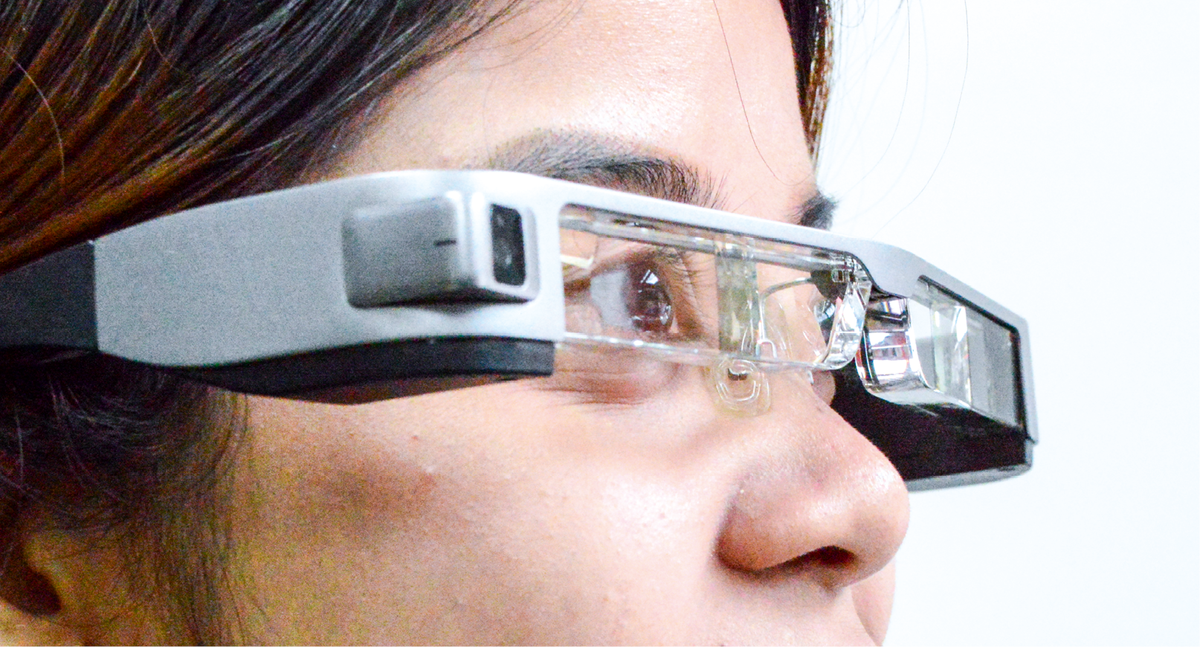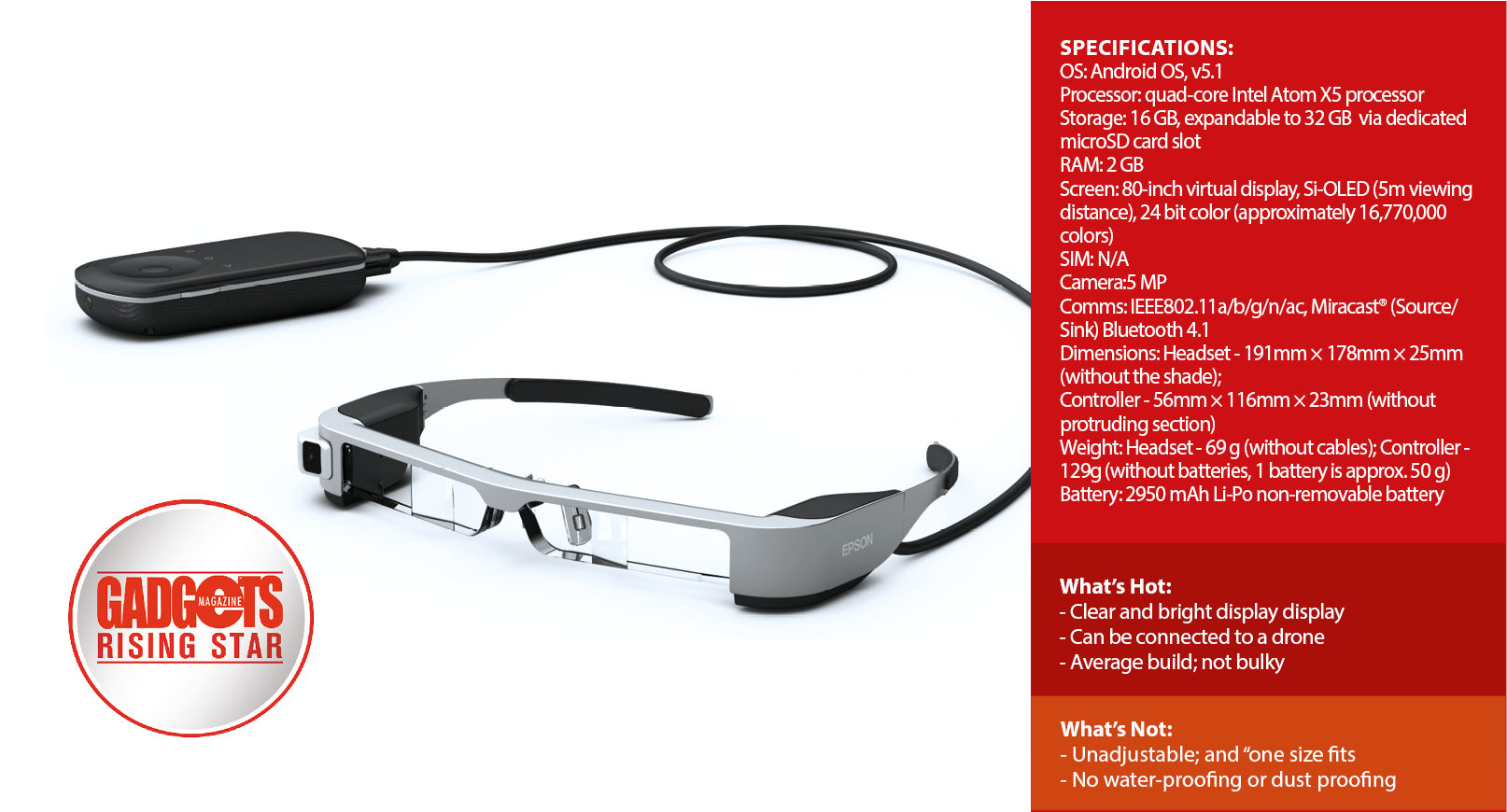Google Glass failed to take off at the time of its release—the world wasn’t ready just yet for AR. It was raw; consumers didn’t want it, nor did businesses. Now, we find ourselves in the year of successful released AR/VR technologies. Slowly transitioning to adoptions of such, we take a look at how Epson is pushing for a technology where even Google once failed.
Design 3.5/5.0
The Epson Moverio is no Google Glass; unlike it, the Moverio consists of a headset and a controller that has its corresponding pros and cons. Augmented reality devices are supposed to effectively tweak or enhance the way you view your environment, wherever you may be. And unlike VR technologies that need not be extremely portable due to it merely projecting virtual images, portability is key when it comes to AR. Point is, for an AR device that’s supposed to successfully augment your environment, it needs to be portable. The Moverio does fit the description of portable, but only just.
Case in point, there’s a bulky controller you’d have to carry with you all the time. Although it’s weight, length and width, could be negligible to the user, it is the thickness that puts it off. True AR is supposed to be seamless, wireless, and is supposed to provide you an experience that doesn’t require you to carry an almost inch-thick device just for you to savor the experience.
The wire adds an additional obstacle to a seamless design. Epson, in its commercial, markets the Moverio as a portable device that’s ready for active lifestyle. It is particular hard to imagine riding bikes and running while a wire constantly dangles by your face. And in case you’ve missed it, the headset has no standalone battery. It’s pretty much paperweight without the bulky controller. Unfortunate? Yes. Very. And if you’d think that you’d be able to adjust it to comfortably fit your head, then you’d be wrong. It sports a one size fits all design folks.
Although the design has its caveats, there’s also some considerable good it brings. First, the glasses themselves are comfortable to wear. It’s light, and its parts that come in contact with your skin doesn’t hurt or cause discomfort, even after long hours. Since the battery, the processor, and pretty much the whole brain and body of the device is embedded inside the controller, wearing the Moverio feels like wearing any other glasses (that’s if it fits you in the first place). The two component design sets the Moverio apart from its big and funny-looking competitors.
Hardware 4.5/5.0
The Moverio packs a quad-core Intel Atom X5 processor, 16 GB of onboard storage and 2 GB of RAM. If the Moverio falls short in its portability, then this is where it makes up for. Often equipped in tablets and in Mini PC desktops, the quad-core Atom X5 processor has proved itself to be decent enough to run games, even on high graphic settings. The Moverio can and will run all apps in its contained Moverio Apps Market smoothly, all thanks to its more than decent processor, and the 2 GB of RAM that complements it. There’s no question about that.
The display is perhaps the most impressive aspect of the Moverio. Putting the glasses on will provide you with a crystal clear 80-inch virtual display that’s perfect for any media consumption. The display, Espon definitely got right. Known for innovative projectors, it was nice to see Epson preserve its legacy of providing superb light-based technologies.

User Experience 3.5/5.0
Despite the Moverio BT-300 being the fourth iteration of Epson’s AR technology, there still isn’t much happening with it. Yes, it’s running Android, but it doesn’t come preinstalled with Google Play Store. Manually installing an apk will just cause the application to crash, and the only real way to be able to run it is through rooting, which many consider risky.Navigating can be done through the controller via the cross-key/enter keys, through the trackpad, or by simply gazing at a particular area, if supported. It might take a little while to get used to, but overall, navigation and control isn’t a hassle.
In lieu of the Play Store, there’s the Moverio Apps Market that packs a few hundred applications. There’s the DJI app for connecting to your drone, a few games here, and a few video apps there. In all honesty, there really isn’t much there yet for you to have that jaw dropping experience. On the consumer side, there just isn’t much. However, enterprise applications tell another story.
Like with other AR technologies, the Moverio works well for enterprise use, especially in the area of simulation and guided access. The Aero Glass, for instance, is able to provide aircraft pilots a navigation solution that includes a visualization of terrain merged with navigation data. For dentists, there’s iDent technology that allows the viewing real time digital impressions during dental operations. Another of which is Apprentice Field Suite that’s able to provide professionals additional leverage in executing their tasks. By way of the Moverio providing real time tools that display complementary information, and by it being able to provide collaborative telepresence, safety reporting and more, professionals are given a cost effective leverage.
There are plethora of tools for professional use, but just a handful for consumers, which is not at all a bad thing. Empowering engineers, doctors, scientists, and other professionals through way of AR technologies is one step closer to an superbly efficient and futuristic society.
Value 3.0/5.0
The Moverio BT-300 retails for USD 779 (PHP 39,954.91). As Epson’s website advises, this the device is only ideal for AR enthusiasts and developers. Unless you’re a hardcore fan, or a developer, or one of the aforementioned enterprise uses, then it might not be advisable to purchase a raw piece of technology.
the world wasn’t ready just yet for AR. It was raw; consumers didn’t want it, nor did businesses. Now, we find ourselves in the year of successful released AR/VR technologies. Slowly transitioning to adoptions of such, we take a look at how Epson is pushing for a technology where even Google once failed.
Bottomline
With the expensive price tag, and limited use, this will only ever be enjoyed by hardcore AR enthusiasts. Practical consumers might want to wait a little more for stable technologies.
